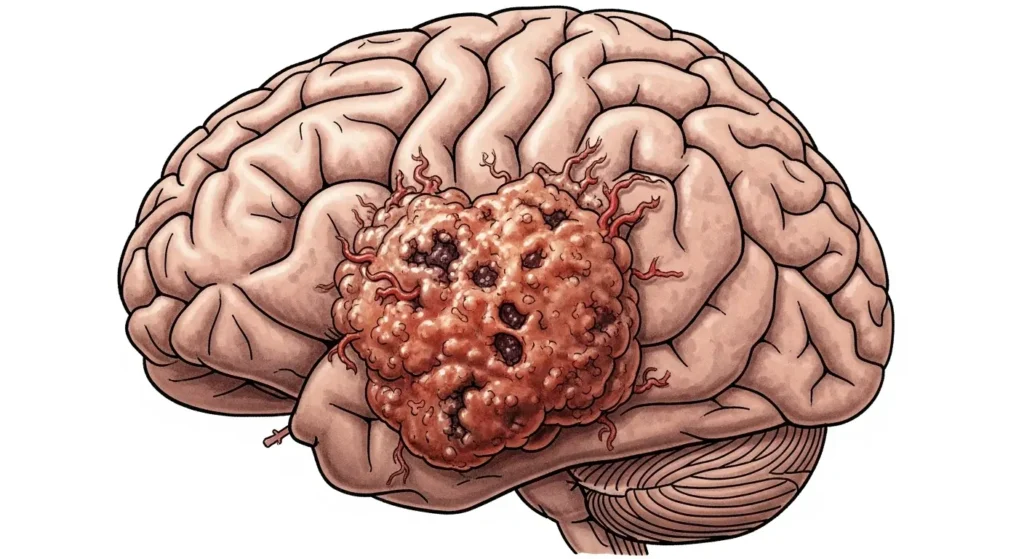Are you worried about hair loss after a brain tumour diagnosis or treatment? Brain tumour hair loss is a distressing yet common side effect caused by surgery, chemotherapy, or radiotherapy.
This guide explains why it happens, outlines the timeline for shedding and regrowth, and shares practical recovery strategies, including expert advice and patient experiences. You’ll gain clarity, reassurance, and medically reviewed guidance for navigating this challenging journey.
What Is Brain Tumour Hair Loss?

Brain tumour hair loss refers to hair shedding that occurs due to either the tumour itself or the treatments used to manage it. Unlike typical hair thinning, this type of hair loss is often sudden, localized, and linked directly to medical intervention.
Definition & Distinction
- Tumour-related hair loss: Pressure on nerves or blood vessels may cause patchy thinning in rare cases.
- Treatment-related hair loss: More common, due to chemotherapy, radiotherapy, or surgery.
Mechanisms
- Radiation-induced alopecia: Radiation damages hair follicles in the targeted area. High doses can sometimes cause permanent scarring alopecia.
- Chemotherapy-triggered anagen effluvium: Rapidly dividing hair follicles are disrupted, leading to sudden shedding of scalp and body hair.
- Surgical effects (craniotomy): Hair is shaved for surgery, and scarring around the incision can prevent regrowth in that area.
Why Does It Happen? (Medical Perspective)
Radiation & Chemotherapy Damage
Radiotherapy uses high-energy beams that can damage hair follicle DNA, while chemotherapy drugs target fast-dividing cells, including hair follicles.
Drug-Specific Effects
Certain drugs like temozolomide, commonly used for brain tumour patients, list alopecia as a side effect.
Temporary vs Permanent Hair Loss
- Temporary: Hair usually grows back once treatment ends.
- Permanent: Higher radiation doses (above 36–40 Gy) can destroy follicles permanently, especially if the radiation field includes sensitive scalp regions.
Timeline: When Hair Falls & Regrows
- Weeks 2–4 of treatment: Hair starts to shed noticeably.
- End of treatment: Hair loss peaks, with patchy or complete scalp shedding depending on treatment type.
- 3–6 months post-treatment: Hair typically begins to regrow.
- 12 months+: In most patients, hair density improves, though new hair may differ in texture or color.
Pro Tip: Regrowth is often finer, curlier, or grayer than before—this is normal and tends to stabilize over time.
Managing Hair Loss: Practical Strategies
Pre-Treatment Planning
- Discuss scalp cooling caps with your oncologist (effective mainly for chemotherapy).
- Consider shorter hairstyles before treatment to minimize the emotional shock of shedding.
Wigs, Scarves, and Head Coverings
- Choose breathable, lightweight wigs for comfort.
- Experiment with scarves and turbans for style and practicality.
Medical Options
- Corticosteroid injections may help with localized patchy loss.
- Hair transplantation is sometimes possible after recovery, once scalp healing and cancer remission are confirmed.
Gentle Scalp Care
- Use mild, fragrance-free shampoos.
- Avoid heat styling and chemical treatments during regrowth.
- Massage the scalp gently to improve circulation.
Coping Emotionally
Hair loss is more than cosmetic—it affects self-image and mental well-being.
Identity and Confidence
Many patients feel that hair loss makes their illness more visible. Addressing this openly with friends and family can ease emotional burden.
Support Networks
- Join local or online support groups for cancer survivors.
- Seek counseling or therapy if feelings of anxiety or depression arise.
Tips for Self-Compassion
- Remember: Hair loss is a sign of your body’s fight against illness, not weakness.
- Explore new styles, headwear, or even going bald proudly.

FAQs
Will my hair be the same color or texture when it grows back?
Not always. Regrowth may appear curlier, finer, or grayer.
Is there any way to prevent hair loss during treatment?
Scalp cooling can help during chemotherapy, but not all patients are candidates. Radiation-induced loss is harder to prevent.
Can a hair transplant work after brain tumour treatment?
Yes, but only after full recovery, stable remission, and a specialist’s approval.
Why did I lose hair only on one side?
Radiation beams often enter and exit through specific scalp areas, causing localized shedding.
How do I choose a good wig or head covering?
Focus on comfort, scalp breathability, and your lifestyle needs—many cancer centers partner with wig suppliers.
Next Steps
If you’re dealing with brain tumour hair loss, remember: your hair does not define your strength or recovery. Discuss openly with your healthcare team the potential side effects of treatment and explore supportive options, such as wigs, scalp care, and future hair restoration.
Ready to Rebuild Confidence?
Hair loss after brain tumour treatment can be challenging, but solutions exist. Whether you need medical advice, emotional support, or advanced hair restoration:
Book a consultation with Dr. Rana Irfan in Islamabad today. Our team specializes in post-treatment hair recovery and will help you take the next step toward regaining confidence.
